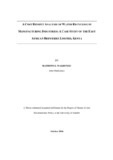| dc.description.abstract | Water recycling offers a potential solution for water scarcity and way for manufacturing industries save on water purchases and wastewater disposal. This is true for large water consumer like East African Breweries Limited (EABL), whose operations are highly dependent on reliable water supply. While water recycling has become a popular concept, little information exists on the costs and benefits of industrial water recycling and the reasons for the reluctance in its adoption. Similarly, Kenya‘s policy and regulations on water recycling are still not widely understood. The aims of this study goal were to compare the costs of treating and recycling water in at EABL to its benefits, shed new light on challenges in greywater recycling at EABL, and evaluate Kenya's regulatory framework on water recycling in the manufacturing sector. This case study carried out between March and July 2016 used both qualitative and quantitative data from primary and secondary sources collected through key informant interviews and literature review. The avoided cost method was used to determine the benefits, while the costs were obtained through data from key informants. The Net Present Values (NPV), benefit cost ratio (BCR) and Internal Rate of return (IRR) were tests used to assess the viability of water recycling at the brewery. The analysis of the data from the interviews and literature review informed the assessment of the challenges and Kenya's regulatory framework industrial water recycling. Results indicated that greywater recycling was economically viable. In fact, the avoided costs by EABL were US$ 241.90 Million, US$ 604.79 Million and US$ 743.06 Million for recycling 10%, 25% and 50% of the water consumed annually respectively. This represented a return of US$ 3.11, US$ 3.65 and US$ 4.01 per invested dollar for 10%, 25% and 50% recycling, respectively according to the Benefit Cost Ratio (BCR). According to the IRR test, all the
recycling capacities were viable regardless of inflation rates. The study also revealed that the high cost of water recycling technologies and lack of incentives were the biggest the challenges that hinder industrial water recycling. Surprisingly, the study found that water recycling was inadequately addressed in water related regulations and there was no institution with the mandate of spearheading water recycling in the manufacturing and domestic sector. In addition, Kenya's regulatory framework leaned towards control of effluent rather than the reduction of wastewater production and promotion of water recycling. The conclusion was that water recycling at EABL was economically feasible for all capacities evaluated in the study. There was need to address these challenges through the reform of the regulatory framework, allocating water recycling responsibility to an institution and awareness creation to improve acceptable of recycled water | en_US |



